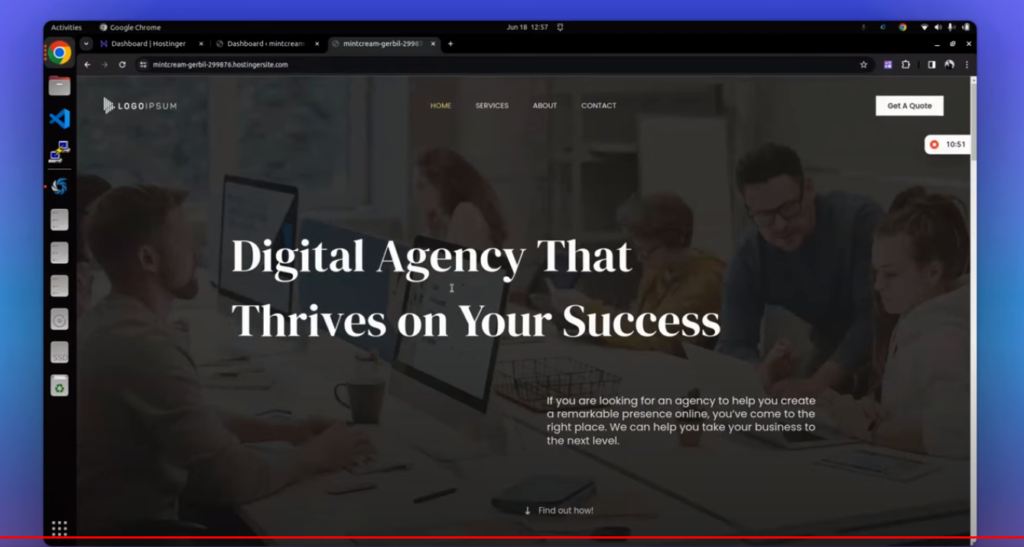Develop a Professional Website
A professional website serves as the cornerstone of your online presence. It is often the first point of contact between your business and potential customers, making it crucial to create a site that is user-friendly, mobile-responsive, and visually appealing.
The website should feature essential information such as your business name, contact details, location, and a comprehensive list of services or products offered. This not only helps in building credibility but also ensures that visitors can easily find what they are looking for.
In addition to the basic information, integrating SEO best practices is vital for your website to rank well in search engines. This includes optimizing page titles, meta descriptions, and using relevant keywords naturally within your content.
High-quality images, fast loading times, and a secure connection (HTTPS) are also important factors that contribute to a better user experience and, consequently, higher search engine rankings.
Given the complexities involved in creating a professional website, you may want to consider hiring a professional web designer. A skilled designer can ensure that your site not only looks good but also functions optimally across different devices and browsers.
They can also help with advanced features such as e-commerce capabilities, appointment scheduling, and integrating social media platforms. Investing in a professional website at the outset can save you time and resources in the long run and provide a solid foundation for your online presence.
Claim Your Google My Business Listing
One of the most critical steps a local business owner can take to enhance their online presence is to claim and verify their Google My Business (GMB) listing. GMB is a powerful tool for local SEO, as it helps your business appear in local search results and on Google Maps, making it easier for potential customers to find you.
By claiming your listing, you take control of the information displayed about your business, ensuring that it is accurate and up-to-date.
To get started, visit the Google My Business website and follow the prompts to claim your business. You will need to provide some basic information, such as your business name, address, and phone number.
Once you’ve completed this step, Google will send a verification code to your business address. This process may take a few days, but it is essential for confirming your ownership and making your listing live.
After your listing is verified, it is crucial to complete your profile with as much detail as possible. Accurate business information, including your address, phone number, and website, ensures that customers can easily contact you. Additionally, add high-quality photos of your business, products, and services to give potential customers a visual sense of what you offer. Clearly state your operating hours to avoid any confusion and ensure customers know when you are open.
Another important aspect of managing your GMB listing is encouraging satisfied customers to leave positive reviews. Reviews play a significant role in building your business’s online reputation and can greatly influence potential customers’ decisions. Responding to reviews, both positive and negative, shows that you value customer feedback and are committed to providing excellent service.
By claiming and optimizing your Google My Business listing, you set a strong foundation for your local SEO efforts, making it easier for customers to find and connect with your business.
Optimize for Local SEO
Optimizing for Local SEO is a critical step in enhancing your online visibility as a local business owner.
This process ensures that your business appears prominently in search results when potential customers are looking for services in your area. One of the primary strategies is the use of location-specific keywords. Incorporate these keywords naturally into your website content, meta titles, and descriptions. For instance, if you own a bakery in Austin, phrases like “Austin bakery” or “best bakery in Austin” should be strategically placed within your content.
Creating local content is another effective method. This could involve writing blog posts about local events, news, or community projects that your business is involved in. Such content not only engages your audience but also signals to search engines that your business is an integral part of the local community.
Equally important is getting your business listed in local online directories. Websites like Google My Business, Yelp, and local chamber of commerce directories can significantly enhance your visibility. Ensure that your business’s Name, Address, and Phone Number (NAP) are consistent across all these platforms. Inconsistent NAP information can confuse search engines and potential customers, leading to a drop in search rankings and trustworthiness.
Additionally, obtaining customer reviews on these platforms can boost your local SEO efforts. Encourage satisfied customers to leave positive reviews and respond to them promptly. This not only improves your rankings but also builds a strong reputation within your community.
By focusing on these aspects of local SEO, you position your business to attract more local customers, improve search engine rankings, and ultimately drive more traffic to your website and physical location. This foundational step is essential for any local business looking to establish a strong online presence from the outset.
Leverage Social Media Platforms
Choosing the right social media platforms is crucial for local business owners aiming to boost their online presence. Begin by identifying where your target audience spends most of their time. For instance, if your business caters to a younger demographic, platforms like Instagram and TikTok may be more effective. On the other hand, if you are targeting professionals, LinkedIn could be a better fit.
Once you have selected the most relevant platforms, set up comprehensive business profiles. Ensure that your profile pictures, cover photos, and descriptions are consistent with your brand’s identity. This consistency helps in building brand recognition and trust among your potential customers.
Regularly posting engaging content is vital for capturing and maintaining the interest of your audience. Share a mix of content types, such as promotional posts, behind-the-scenes looks at your business operations, and customer testimonials. This variety keeps your feed interesting and provides value to your followers. Additionally, content like behind-the-scenes footage can humanize your brand, making it more relatable and approachable.
Interaction is another key element of leveraging social media effectively. Make it a habit to respond to comments, messages, and reviews promptly. Engaging with your audience fosters a sense of community and encourages loyalty. You can also use polls, questions, and interactive stories to involve your audience and gather valuable feedback.
Building a community around your brand is a long-term investment that pays off by creating advocates for your business. Encourage user-generated content by asking customers to share their experiences with your products or services on their own profiles. Reposting this content not only provides social proof but also shows that you value your customers’ input.
In summary, leveraging social media platforms effectively involves selecting the right platforms, setting up consistent business profiles, posting engaging content, and actively interacting with your audience. These actions collectively help in building a strong online presence for your local business.
Set Up an Email Marketing Campaign
Email marketing represents a cornerstone strategy for local business owners aiming to foster direct and meaningful connections with their audience. By establishing a robust email marketing campaign, businesses can effectively communicate updates, promotional offers, and valuable content to their customers.
The first step in this process is to collect email addresses, which can be done through various channels such as your website or in-store sign-ups. Offering an incentive, like a discount or a freebie, can encourage more customers to subscribe to your list.
Once you have a growing list of subscribers, it is essential to utilize email marketing software. Platforms such as Mailchimp, Constant Contact, or Sendinblue provide tools to design, schedule, and send emails efficiently. These tools also offer analytics to track open rates, click-through rates, and other key performance indicators, allowing you to refine your strategy over time.
Regular newsletters serve as an excellent medium to keep your audience informed about business developments, upcoming events, and special promotions. Consistency in sending out these newsletters helps maintain engagement and keeps your business top-of-mind. However, it is crucial to ensure that the content is relevant and valuable to your subscribers to avoid high unsubscribe rates.
Personalization is another vital aspect of email marketing. Tailoring your emails to address your customers by name and segmenting your email list based on customer behavior and preferences can significantly enhance engagement.
For instance, sending targeted offers to loyal customers or tailored content based on previous purchases can foster a deeper connection with your audience.
Incorporating email marketing into your overall digital strategy not only boosts your online presence but also builds a loyal customer base. By continually engaging your audience through thoughtful and personalized email campaigns, you can drive repeat business and cultivate a community around your brand.
Create Quality Content
Content marketing is a critical strategy for establishing your business as an authority in your industry. As a local business owner, creating quality content should be one of your top priorities. Start by launching a blog on your website and committing to a regular publishing schedule. High-quality, relevant content that addresses the needs and interests of your target audience can significantly enhance your online presence.
Begin by identifying the key topics that resonate with your audience. These could range from industry insights and how-to guides to customer success stories and product updates. Ensure that the content is not only informative but also engaging and valuable. Utilizing a mix of content types such as blog posts, videos, infographics, and podcasts can cater to different audience preferences and keep your content fresh and dynamic.
Once your content is created, it’s essential to share it on multiple platforms to maximize reach and engagement. Social media channels are particularly effective for this purpose. Regularly post your content on platforms like Facebook, Twitter, LinkedIn, and Instagram to attract a wider audience. Additionally, email newsletters can serve as a direct line to your customers, keeping them informed and engaged with your latest content.
Furthermore, leveraging search engine optimization (SEO) techniques within your content can improve your visibility on search engines. Use relevant keywords naturally throughout your articles, and ensure your content is well-structured with clear headings and subheadings. High-quality content not only attracts visitors but also encourages them to stay longer on your site, reducing bounce rates and improving your overall search engine ranking.
In essence, by consistently creating and sharing quality content, you position your business as a trusted resource in your field. This not only boosts your online presence but also helps build a loyal customer base over time.
Utilize Online Advertising
Online advertising is an essential tool for local business owners looking to boost their online presence effectively. Platforms like Google Ads and social media ads offer robust solutions to reach a broader audience in a relatively short period. To begin with, it is crucial to set a budget that aligns with your business goals and financial capabilities. This budget will guide your advertising efforts and help you maintain financial discipline.
Targeting is another pivotal aspect of online advertising. Platforms provide various options to narrow down your audience based on demographics, interests, and geographic locations. For instance, if you own a local bakery, you can target ads to individuals within a specific radius of your shop who have expressed interest in baked goods. Such precision ensures that your ads are seen by potential customers who are more likely to convert.
Monitoring the performance of your ads is vital to ensure you are getting the best return on investment (ROI). Most advertising platforms offer analytics tools that allow you to track key performance indicators (KPIs) such as click-through rates, conversion rates, and cost per conversion. Analyzing these metrics will provide insights into which ads are performing well and which ones need adjustments.
Adjusting your strategy based on performance data is crucial for maximizing ROI. If certain ads or keywords are underperforming, consider reallocating your budget to the more successful ones. Additionally, continuously experiment with different ad formats, messages, and targeting options to identify what resonates best with your audience.
In summary, utilizing online advertising effectively requires a strategic approach. By setting a clear budget, precisely targeting your audience, and continually monitoring and adjusting your campaigns, you can significantly enhance your online presence and drive more traffic to your local business.
Engage with Online Reviews
Online reviews wield considerable influence over a local business’s reputation and success. Platforms such as Yelp, TripAdvisor, and Google Reviews serve as critical touchpoints where potential customers form opinions about your offerings. As a business owner, it is crucial to actively monitor these review sites to stay aware of public sentiment and address any concerns promptly.
Responding to reviews, both positive and negative, should be an integral part of your customer engagement strategy. When customers leave positive feedback, acknowledge their comments with gratitude. A simple “thank you” goes a long way in fostering customer loyalty and turning satisfied clients into brand advocates. This positive interaction can also enhance your online visibility, as platforms often reward businesses that engage with their users.
Addressing negative reviews, however, requires a more nuanced approach. Respond professionally and promptly, demonstrating your commitment to resolving issues and improving customer experience. Avoid defensive language; instead, express empathy and a genuine willingness to rectify the situation. For instance, if a customer complains about a delayed service, acknowledge their inconvenience and outline steps you’re taking to prevent future occurrences. This not only shows that you value customer feedback but also publicly displays your dedication to quality service.
Encouraging satisfied customers to leave reviews is equally important. Implement strategies such as follow-up emails, post-purchase surveys, or in-store signage to remind customers to share their experiences online. Positive reviews can significantly enhance your business’s credibility and attract new clientele. Additionally, analyzing feedback from reviews can provide valuable insights into areas for improvement, helping you refine your services and better meet customer needs.
By actively engaging with online reviews, you can cultivate a robust and positive online presence, essential for the growth and sustainability of your local business. Consistent, thoughtful interaction with your customer base will not only improve your reputation but also build a loyal community around your brand.
Network with Other Local Businesses
Building strong relationships with other local businesses is a crucial step for any new business owner looking to enhance their online presence. Networking offers a multitude of benefits that can significantly impact your business’s visibility and growth. By engaging with other local businesses, you open doors to valuable opportunities such as referrals, joint promotions, and community involvement, all of which contribute to a stronger online presence.
Collaborating on joint promotions is an effective strategy to reach a wider audience. Partnering with businesses that complement your own can create mutually beneficial promotional campaigns. For instance, if you own a bakery, teaming up with a local coffee shop for a combined discount offer can attract customers to both establishments. Such collaborations not only increase your customer base but also provide opportunities for social media mentions and backlinks, which are essential for improving your search engine rankings.
Sponsoring local events is another excellent way to network and boost your online presence. By supporting community events, you not only show your commitment to the local area but also gain exposure to potential customers. Sponsorships often come with opportunities for brand visibility through event marketing materials, websites, and social media posts, further enhancing your online reach.
Engaging in community activities also plays a significant role in networking. Participating in local fairs, charity events, or business association meetings allows you to connect with other business owners and potential customers. These interactions can lead to word-of-mouth referrals and valuable backlinks from local business directories or community blogs.
Networking with other local businesses is a strategic approach to increasing your online presence. The relationships you build can lead to collaborations, sponsorships, and community engagement, all of which contribute to a robust online presence through referrals, social media mentions, and backlinks. As a local business owner, investing time in networking is essential for long-term growth and visibility in the digital landscape.
Monitor and Analyze Your Online Performance
Regularly tracking and analyzing your online performance is crucial for any local business owner looking to boost their online presence. Utilizing tools such as Google Analytics, Google Search Console, and various social media analytics platforms can provide invaluable insights into how your digital strategies are performing.
Google Analytics is an essential tool that allows you to monitor key metrics such as website traffic, user behavior, and conversion rates. By understanding where your traffic is coming from and which pages are performing well, you can make data-driven decisions to enhance your website’s effectiveness. For instance, if a particular page has a high bounce rate, it could indicate that the content is not engaging enough, prompting you to make necessary adjustments.
Google Search Console, on the other hand, offers insights into how your site appears in search results. It provides data on search queries that bring visitors to your site, indexing issues, and mobile usability. By regularly reviewing this information, you can optimize your content and technical aspects of your site to improve its visibility in search engine results.
Social media analytics are also crucial for understanding how your audience interacts with your content across different platforms. Metrics such as likes, shares, comments, and overall engagement rates can indicate the effectiveness of your social media strategies. By analyzing these metrics, you can identify which types of posts resonate most with your audience, allowing you to tailor future content accordingly.
Consistent monitoring and analysis of these metrics will enable you to identify areas for improvement and adapt your strategies to better meet your business goals. Whether it’s tweaking your website content, improving search engine optimization, or refining your social media campaigns, using data-driven insights is key to enhancing your online presence and achieving long-term success.
How to Be Searchable Online: A Guide for Businesses to Attract Local Customers
Understanding Local SEO Local Search Engine Optimization (SEO) is a multifaceted approach that enhances a…
Create an Agency website in less than 10 min with this WordPress AI Content Creator
Prepare to be amazed by the speed and simplicity of this incredible AI tool! In…
Amazon Affilate Challenge – Will this make money? – PART 1
I’ve had the domain name www.buyersguide.wiki for serveal years with no website on it until…
Grow fast on X using TweetHunter
Grow faster with TweetHunter: http://tweethunter.io/?via=start Join me in this video where I reveal my strategy…
My Initial Review of the Beehiiv newsletter / blogging platform
I just signed up to Beehiiv and this my my Initial blind review of their…
How to Remove the Background from a Picture Using Canva: Step-by-Step Instructions
Introduction to Canva and Background Removal Canva has rapidly become one of the most popular…








